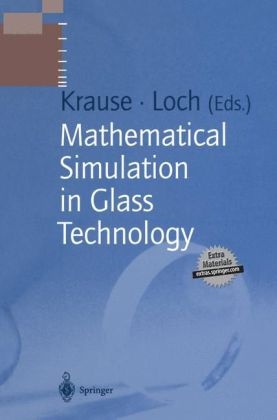Read more
This volume reports on a large variety of mathematical simulations, covering all production steps of special glass manufacturing: melting, fining, mixing, homogenizing, hot and cold forming, thermal treatment, post-processing. Modern, commercially available software packages have been used and - whenever necessary - modified to satisfy the special requirements and situations in liquid or solid glasses, or the boundary conditions of forming processes. The mathematical approach often helps in understanding the overall and sometimes hidden features of processes and thus is a highly efficient tool for optimization efforts. Complementing and partly replacing experimental investigations, mathematical simulation makes possible considerable savings in time and money. Several of the results reported here are unique and published for the first time. The CD-ROM shows 27 simulations of different aspects such as surprising details of the pressing and casting process.
Systemvoraussetzungen:
PC, Windows 95/98/ME/2000/NT/XP, Netscape or the MS IE is needed.
List of contents
From the contents:
- Overview (H. Loch)
- Melting and Fining (R. G. C. Beerkens)
- Homogenizing and Conditioning (H. Eisermann, U. Lange, H. Loch, G. Weidmann)
- Shaping at Low Viscosities (M. Brinkmann, N. Siedow)
- Reshaping at High Viscosity (M. Brinkmann, N. Siedow)
- Thermal Treatment (P. Thomas, C. Kunisch)
- Post-Processing by Laser Cutting (K. Nattermann, C. Hermanns)
- Glass Products under Mechanical and Thermal Loads (K. Nattermann, H. Krümmel, L. Frank)
- Simulation and Test of the Spinning Process Applied to Platinum Metals (S. Nzahumunyurwa, H
- J. Hoffmann, H. Oechsner, J. Disam)
Summary
This book, entitled Mathematical Simulation in Glass Technology, is one of a series reporting on research and development activities on products and processes conducted by the Schott Group. The scientifically founded development of new products and technical pro cesses has traditionally been of vital importance to Schott and has always been performed on a scale determined by the prospects for application of our special glasses. Since the reconstruction of the Schott Glaswerke in Mainz, the scale has increased enormously. The range of expert knowledge required could never have been supplied by Schott alone. It is also a tradition in our company to cultivate collaboration with customers, universities, and research institutes. Publications in numerous technical journals, which since 1969 we have edited to a regular schedule as Forschungsberichte - "research reports" - describe the results of these cooperations. They contain up-to-date infor mation on various topics for the expert but are not suited as survey material for those whose standpoint is more remote. This is the point where we would like to place our series, to stimulate the exchange of thoughts, so that we can consider from different points of view the possibilities offered by those incredibly versatile materials, glass and glass ceramics. We would like to share the knowledge won through our research and development at Schott in cooperation with the users of our materials with scientists and engineers, interested customers and friends, and with the employees of our firm.
Additional text
From the reviews:
"This volume reports on a large variety of mathematical simulations, covering all production steps of special glass manufacturing ... . The mathematical approach often helps in understanding the overall and sometimes hidden features of processes and thus is a highly efficient tool for optimization efforts. Complementing and partly replacing experimental investigations, mathematical simulation makes possible considerable savings in time and money. Several of the results reported are unique and published for the first time." (Verre Bulletin d’informations, Vol. 9 (1), 2003)

